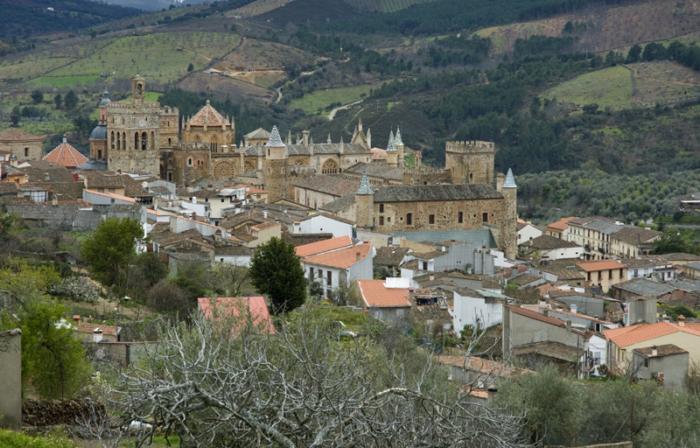| Royal
Monastery of Santa Maria de Guadalupe occupying most of the town of Guadalupe,
this was the most important monastery in Spain
for more than four centuries

History
Sometime around 714, a group of Christians
were forced to flee from Seville ahead of Moorish
invaders. Amongst their possessions was a black
ebony statue of the Virgin Mary, which they hid
in a cave near the River Guadalupe. The statue
lay hidden until the end of the 13th century,
when it was discovered by a Cáceres shepherd
named Gil Cordero. Cordero built a chapel to
house the statue, and that structure grew into
the one seen today.
The chapel built by Cordero soon became a
church, which was enlarged by command of King
Alfonso XI in 1337. The king invoked the
protection of Our Lady of Guadalupe for the
battle of Salado in 1340 and, following his
victory, declared the church a royal sanctuary,
founding a secular priory there. Reverence for
the statue of the Virgin Mary quickly became
widespread, especially in the kingdoms of
Castille and Portugal.
In 1389 the Order of Saint Jerome took over
the sanctuary, and with it the pastoral care and
secular overlordship of the village it still
dominates. For 447 years under the Hieronyrnite
Order the Monastery played a very influential
role in the history of Spain, being associated by
the crown with important events, notably by the
Catholic Kings with the conquest of Granada and
the discovery of America in 1492.
With the General Secularization of 1835, the
Order of Saint Jerome passed responsibility for
the sanctuary to the Archdiocese of Toledo, which
handed it over to the Franciscan Order in 1908.
The Royal Palace, built on the instructions of Queen
Isabella in 1487-91, was demolished in 1856. Pope
Pius XII conferred the title of Minor Papal
Basilica on the main church in 1955. Declared a
World Heritage Centre by UNESCO
in 1993, tourists can only see the interior via a
guided tour, which ends with a
"presentation" of the Virgin Mary
statue which "started it all."

Main Buildings
The main Gothic Church (Templo Major) has a
notable facade with ornamented doors bearing
finely wrought bronze plaques. The interior has
three naves with fine ornamented vaulting, tombs
and altars.
The Sacristy, built between 1638 and 1647, and
exuberantly decorated, is best known for a series
of paintings by Zurbarán on its walls. These
austere representations of monks of the
Hieronymite order and scenes from the life of St.
Jerome are the artist's only significant
paintings still in the setting they were made
for.
The Chapel of Santa Catalina, constructed in
the 15th century, links the Sacristy with the
Reliquaries Chapel. It has an octagonal cupola
lit by a lantern and contains outstanding 17th
century tombs.
The Reliquaries Chapel is an octagonal-plan
edifice built at the end of the16th century. The
lower part houses many elaborate reliquaries and
other works of art.
The Camarín de la Virgen, built between 1687
and 1696, is a small octagonal building situated
behind the presbytery of the basilica. Its upper
story contains the "Chamber of the
Virgen" proper, which houses the famous
statue of the Virgin of Guadalupe, on a
magnificently ornamented throne. The dark,
mysterious wooden figure hides under a heavy veil
and mantle of red and gold. Each September 8, the
Virgin is brought down from the altarpiece and
walked around the cloister in a procession with
pilgrims following on their knees.
The Mudejar Cloister, built between 1389 and
1405, is situated to the north of the main church
and is constructed in brick, in the Mudejar
tradition, and painted in white and red. The
small chapel in the center dates from 1405, and
there is an impressive portal of 1520-24 in
Plateresque style. The interior is decorated with
paintings telling the history of the Virgin and
the miracles she wrought. In one of the three
museums spaced around it is a gallery that
includes three paintings by El Greco (St Andrew,
the Assumption, and St Peter), a sombre late Goya
(Confession in Prison), a fine Ecce Homo by Pedro
de Mena, a handful of monks by Francisco de
Zurbarán and a beautiful little ivory
crucifixion attributed to Michelangelo.
The Gothic cloister dates from 1531-33 and has
galleries on three sides. As it belongs to the
hospice of the monastery it does not contain any
important works of art.
One of the descendants of Christopher
Columbus, who himself had a special affection
for the monastery, promoted the construction of
the New Church in 1730-35, in modified Baroque
style with three naves.

UNESCO http://whc.unesco.org/en/list/665

Queen
Isabella
Pope
Pius XII
UNESCO
Christopher
Columbus
Questions or comments about
this page?
|



